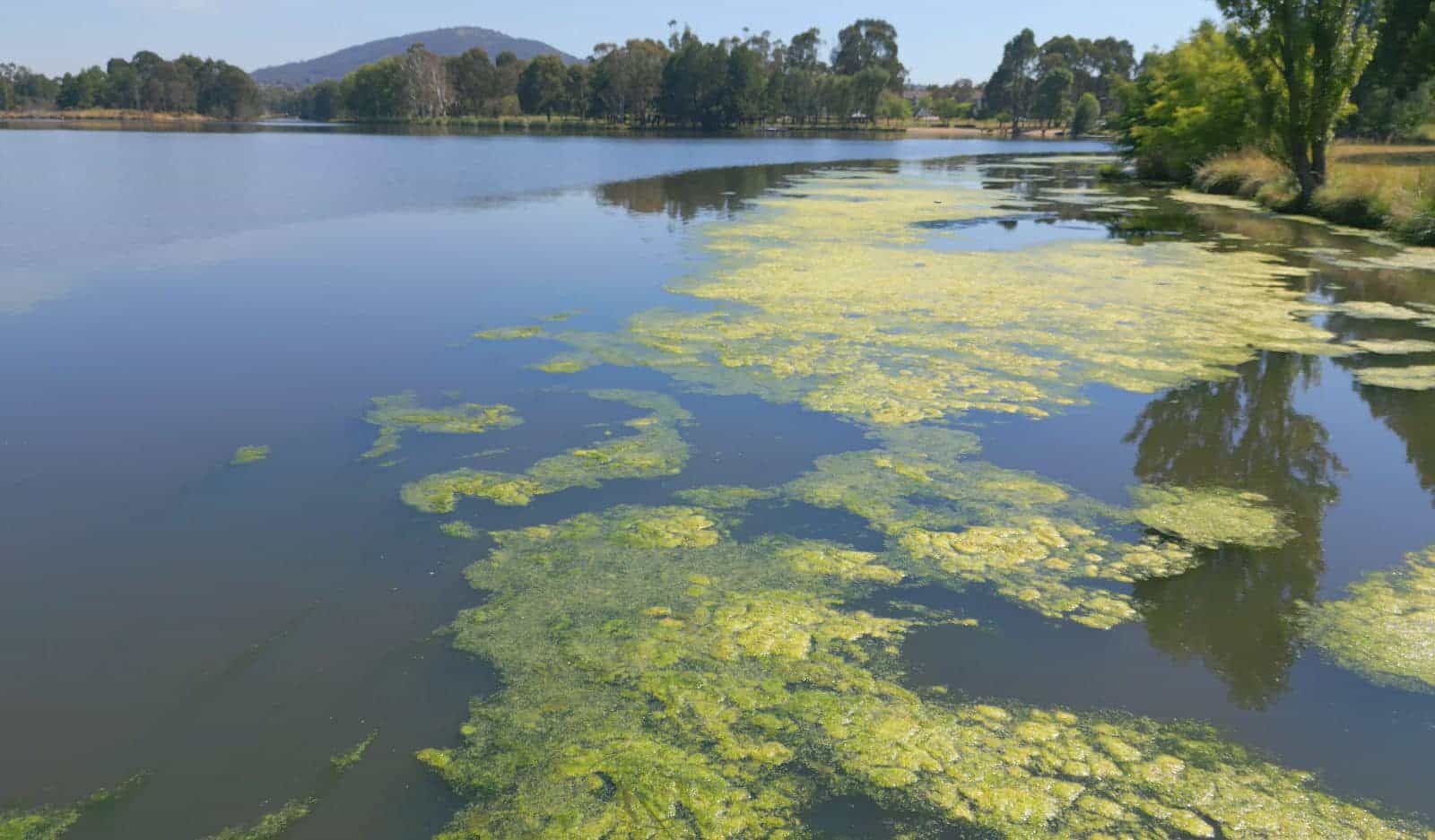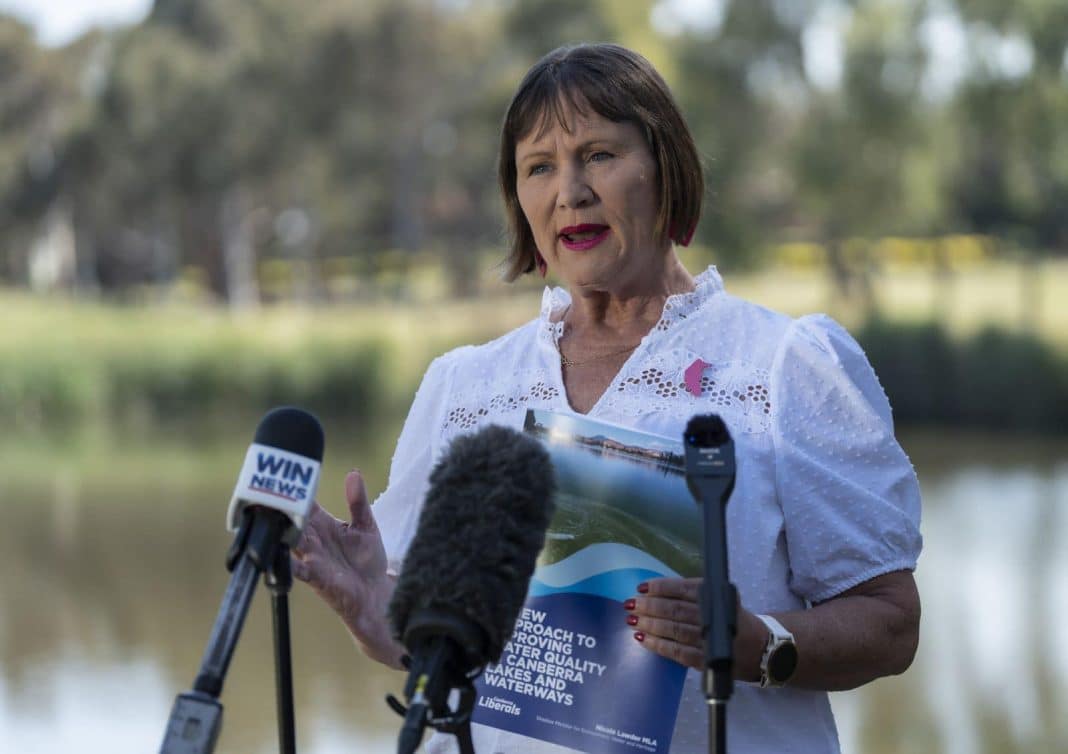For years, the stench of Lake Tuggeranong has troubled Canberrans, while the lake is closed for four months every year due to blue-green algae. But Liberal MLA Nicole Lawder, Shadow Minister for Environment, Heritage and Water, has some suggestions.
This week, she released A New Approach to Improving Water Quality in Canberra Lakes and Waterways, a discussion booklet outlining professional advice from water experts, that could be used across the ACT. But as a Tuggeranong resident, her local lake is her priority.
“By all accounts, Lake Tuggeranong is the worst affected waterway with regard to water quality in the ACT,” Ms Lawder said.
“As a proud long-term Tuggeranong resident, I know how valued the lake and its surrounds are by our southside community. I remember when my family and I used to go for a swim in Lake Tuggeranong, and it’s disappointing that families today can’t share those same wonderful memories.”
Last year, Waterwatch’s Catchment Health Indicator Program (CHIP) 2021 Report failed Lake Tuggeranong: its result was D+ (Poor), its worst score yet recorded. Nitrate concentrations and dissolved oxygen levels were degraded, and large blue-green algae (cyanobacteria) blooms appeared from summer until April.
Blue-green algae and faecal contamination are the most serious issues, Ms Lawder argues. In fact, according to her report, blue-green algae blooms have been a problem for 25 of the 34 years since Lake Tuggeranong was constructed.
- Extreme blue-green algae alert for Lake Tuggeranong (7 January 2022)
- Updated: Extreme blue-green algae alert for Lake Tuggeranong (11 March 2021)
- High blue-green algae alert for Lake Tuggeranong (24 December 2020)
Toxins, according to CSIRO, may cause health problems for people and animals, the report states. They also degrade the social value and amenity of the lake; the lake cannot be used for water sports; and nearby businesses suffer from reduced foot traffic. Lake Tuggeranong is closed for primary contact on average for 15 weeks per year (29 per cent of the time), the report observes.

Shane Rattenbury, ACT Minister for Water, agrees that the water quality in Lake Tuggeranong needs to be improved.
“It has been our most problematic lake,” he said. “I know residents of the area are really disappointed that they’re not able to use the lake for recreational purposes, whether it’s letting their dogs swim or going for a swim themselves.”
Lake Tuggeranong has been on the Greens’ agenda: last year, Johnathan Davis MLA moved for the government to do more to protect Lake Tuggeranong from grass clippings and leaf litter.
- Greens call on government to protect Lake Tuggeranong (24 November 2022)
“One of the big challenges with Lake Tuggeranong is it was designed to catch pollutants, and prevent them going into the Murrumbidgee river,” Mr Rattenbury said. “So, in a way, it’s doing its job extremely well, but that means the water quality is deteriorating. … [Canberra lakes] are very susceptible to the build-up of nutrients, which is what leads to the blue-green algae outbreaks. … And so we’ve got a 30- or 40-year legacy to turn around, and that’s what the government is now investing in.”
The government’s Healthy Waterways program aims to improve the quality of water entering Canberra’s lakes and waterways before flowing downstream into the Murrumbidgee River system. Last year, the government boosted the Healthy Waterways program by $14 million to try to stop pollution at its source. The government has also invested in University of Canberra water research, urban rain gardens, floating wetlands in Lake Tuggeranong and Yerrabi Pond, and subsurface wetlands at Lake Ginninderra.
- Floating wetlands make a splash in Lake Tuggeranong (29 March 2021)
- Floating wetlands to clean up Yerrabi Pond (22 October 2021)
- ACT’s first subsurface wetland to be built in Belconnen (8 October 2022)
Ms Lawder acknowledges that the ACT Government has spent $35 million since 2014 to address the water quality of Lake Tuggeranong, and the Liberals broadly supported these attempts, but she does not believe the government’s approach is right.
“Tens of millions of dollars have been spent, yet Lake Tuggeranong still suffers the same problems it always has,” Ms Lawder said.
She attributes these continuing problems to unrealistic water quality targets, inadequate systems for monitoring, lack of evidence-based decision-making, no reporting, and poor planning.
For instance, according to the National Guidelines (2008), a 70 to 90 per cent reduction in phosphorus is needed to reduce algal blooms to a low to moderate level. But, Ms Lawder says, the ACT government’s target level for total phosphorus concentration (<0.1 mg/L) is three times the level needed to reduce the risk of algal blooms (0.035 mg/L); and the phosphorus load target for Lake Tuggeranong (the maximum total amount of phosphorus that should flow into the lake in an average year) is double what it needs to be.
Ms Lawder’s “new approach” comprises 10 recommendations. First is to make the Office for Water the single point of contact on water quality in the ACT, and give it “teeth”. Founded in July, the bureau brings together ACT public servants from different agencies working on water, and was set up to lead water policy, identify opportunities and gaps across the system, and improve water management.
According to Ms Lawder, disparate responsibilities for water quality across ACT Government directorates divided responsibility and accountability for achieving improvements. For instance, she says, the 10-year draft Canberra Urban Lakes and Ponds Land Management Plan has no timeline for implementation, and is not much different to the 20-year-old 2001 version.
Mr Rattenbury agrees that the ACT needs a single body for water, which is why the Office for Water – a Greens election promise – was established.
“Historically, we did have people spread out across ACT government that were responsible for water, and they are a bit isolated, and weren’t necessarily working as well together as they might. That’s why we’ve created the Office for Water to get better co-ordination, to get a bigger critical mass of people working together on water policy issues, so that we can get better understanding and better quality work,” he said.
Ms Lawder also advises lifting the water quality targets in the ACT standards, codes, and guidelines; treating water from upstream to downstream; reducing nutrients from entering the lakes; determining the relative capital and maintenance costs of assets and treatments for their efficiency in removing pollutants; optimising the cleaning frequency of gross pollutant traps; increasing street sweeping; recycling organics and sand; prioritising treatment areas; and ensuring the Environment Protection Authority has the power to protect lakes and waterways.
Reporting needs to be improved, Ms Lawder believes. According to her, the ACT Government stopped annual reporting of recreational water qualities in 2015, while the ACT Commissioner for the Environment’s 2022 report on the State of Lakes and Waterways of the ACT states that a number of recommendations and concerns remain relevant, including some ACT Government directorates have assessed as complete. That report advises revisiting recommendations and further reporting.
Mr Rattenbury said the government had a number of annual reporting mechanisms: the CHIP report, using data from citizen scientists who measure water quality across dozens of sites all year round; and the ACT Water Strategy Report Card on implementation of policy.
“We’ve got both data and policy measurement,” Mr Rattenbury said. “Combined, these are quite valuable sources. They give us good indications of where our problem areas are, and where there’s further room for improvement.”
Ms Lawder estimates that $100 million over the next 10 years is needed to meet water quality targets in Lake Tuggeranong – $400 million across the ACT – but she notes that closing Lake Burley Griffin costs $25 million per year.
Mr Rattenbury thinks fixing the water quality in Canberra’s lakes will be expensive. “Lake Tuggeranong has been the worst historically, but Lake Ginninderra is also an emerging issue that we need to invest in.” He hopes the new subsurface wetland in Belconnen will hopefully prevent it getting worse. University of Canberra research has shown that the nutrients come from further up the catchment than thought.
“And so we’re now changing strategy, making the interventions higher up the catchment to prevent the nutrients getting even close to the lakes at all. I think these subtle changes in strategy over time, based on that University of Canberra research, will improve both the water quality going into the lakes and therefore, the water quality in the lakes.”
Both Ms Lawder and Mr Rattenbury encouraged the community to look after the lake. Ms Lawder advises the public to join a local environment group that helps stop pollutants entering the lake, or monitor water quality.
- Don’t wash leaves and garden debris like grass clippings down the drain. Sweep them up and add to your compost, but make sure the compost heap doesn’t drain into the stormwater system. Clean your backyard sumps regularly. Use your green bin for excess organic material.
- Don’t over apply fertiliser, especially just before rainfall, so that the fertiliser doesn’t get washed down the drain.
- Talk to your neighbours about keeping gutters clear of leaf debris.
“The community is going to be vital in helping turn around the water quality in our lakes,” Mr Rattenbury said.
“The government is making investment in infrastructure, but it’s not all about the infrastructure; it’s also about slowing down the amount of nutrients going in. And that means people not raking the leaves into their gutters – in fact, raking leaves out of their gutters, and just playing that little role. Now, government street sweeping will also be an important part of that, but there’s a role for everybody to improve water quality in our lakes.”



